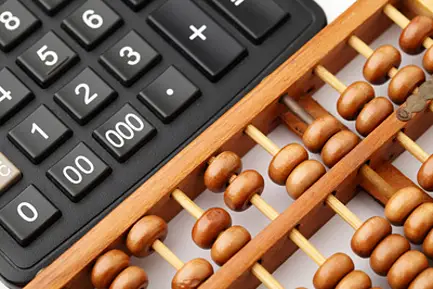08.27.2016
The Evolution of Calculators
Prior to the advent of calculators, the abacus, slide-ruler, mathematical tables and other non-electronic tools were used to perform simple and complex calculations. Not only was the work tedious and time-consuming, the reliability of these aids were extremely suspect. By the 1980s, calculators had become more readily available to the general public and began to be used in all walks of life, including in the classroom. Calculators are now as apt to be encountered by the public as software rather than hardware.
Electronic calculators
Electronic calculators were a vast improvement over mechanical calculations in that they were capable of performing both basic and complex arithmetical operations. The first electronic calculator was developed in the 1960's and since that time radical technological improvements have resulted in smaller, more advanced devices.
Imagine using a calculator as large as a modern desktop computer. Prior to the 1970s, calculators were bulky and expensive, only able to perform a limited number of tasks. The invention of microprocessors, which allowed for the development of smaller devices, helped driving down production costs which is indirectly responsible for the increased popularity of calculators. Scientific and Financial calculatorsSpecialized calculators are able to perform a wider range of functions than the standard calculator that most people use in their daily lives. Unlike the standard 4 function calculator, scientific calculators were designed to do many of the functions normally associated with slide rulers. These functions can include but are not limited to statistical and probability calculations, logarithmic functions, calculus, exponential functions, and trigonometry.
Hewlett-Packard was an early pioneer in the scientific calculator market, introducing the HP – 9100A in 1968. Later the company introduced the first pocket scientific calculator, the HP 35. Casio, Texas instruments and Sharp have also played key roles in the development & improvement of the scientific calculator.
Financial calculators share some similarities with scientific calculators such as the ability to perform higher level mathematical calculations. Most financial calculators include special keys for specific financial calculations. Unlike standard calculators, a financial calculator may be programmed by the user to include functions that were not originally built into the device.
Use in the classroom
On the opposite side of the argument, some educators believe that by freeing up students from having to perform routine work, calculators actually leave the student with more time to focus on core mathematical concepts. Rote memorization of basic concepts isn't necessary when the answer is readily available at the push of a button. However, this same dependence on calculators for routine functions is one of the major concerns educators have about computers.
There is also no denying that overuse of calculators could potentially pose a serious threat to student comprehension of arithmetical concepts. The user is responsible for inputting the data that the calculator depends on to deliver the correct results. When the student doesn't have the requisite knowledge of arithmetical concepts they are prone to miss errors that result from their own ignorance. Ironically, over-reliance on calculators can lead students to use the devices incorrectly.
The problem can extend beyond academics. Failure to recognize a mistake in a calculation can have serious real world consequences. Even a minor miscalculation can be disastrous in the world of business and engineering where precision is required. Without the bedrock knowledge of mathematics, that is a prerequisite in many fields, errors may only be noticed once it's too late.
Calculators vs computersThe word computer has become a blanket term that many people incorrectly use to classify a broad range of electronic devices including calculators. In fact, there are several differences between calculators and computers. Most notably, a computer is more versatile, able to be programmed to execute any number of tasks. A standard calculator is limited to a set number of mathematical functions which cannot be altered by the user. This isn't true of more specialized calculators, such as drafting calculators, which are designed with programming functions.
Additionally, computers can do a number of functions simultaneously, unlike a calculator which can perform only one operation at a time. This is because of another key difference between calculators and computers; a computer is able to store data.
Another key difference can be found in the user's interaction with the device. For calculation purposes, the device must receive specific instructions from the user in the form of pushing buttons on the device. A computer performs most of its functions almost independent of the user, requiring very little input to execute a host of tasks.
For most consumers, price is the number one consideration when purchasing a calculator. While the speed of the processor continues to be an important feature when purchasing a computer, it isn't as vital when it to calculators since the speed of the device is largely dependent on the dexterity of the user who must manually enter the data. Calculator designers tend to focus more on functionality than speed, with the result that logic elements are a bigger concern than the number of clock cycles needed to perform a task. |
 GoodCalculators.com
A collection of really good online calculators for use in every day domestic and commercial use!
GoodCalculators.com
A collection of really good online calculators for use in every day domestic and commercial use!
- Salary & Income Tax Calculators
- Mortgage Calculators
- Retirement Calculators
- Depreciation Calculators
- Statistics and Analysis Calculators
- Date and Time Calculators
- Contractor Calculators
- Budget & Savings Calculators
- Loan Calculators
- Forex Calculators
- Real Function Calculators
- Engineering Calculators
- Tax Calculators
- Volume Calculators
- 2D Shape Calculators
- 3D Shape Calculators
- Logistics Calculators
- HRM Calculators
- Sales & Investments Calculators
- Grade & GPA Calculators
- Conversion Calculators
- Ratio Calculators
- Sports & Health Calculators
- Other Calculators
 Today, calculators are so ubiquitous that's it's hard to imagine there was a time when their use was largely confined to engineers and academics. Calculators were once strictly stand-alone devices that were quite large by modern standards and limited to a few basic functions. Calculators are now included in many personal electronic devices such as mobile phones and iPads and may be as small as a key chain. Advances in electronics have greatly improved calculator functionality, allowing for a wider range of applications such as those found in financial and scientific calculators. Yet, despite all of these improvements, today's calculators are actually more affordable than earlier versions.
Today, calculators are so ubiquitous that's it's hard to imagine there was a time when their use was largely confined to engineers and academics. Calculators were once strictly stand-alone devices that were quite large by modern standards and limited to a few basic functions. Calculators are now included in many personal electronic devices such as mobile phones and iPads and may be as small as a key chain. Advances in electronics have greatly improved calculator functionality, allowing for a wider range of applications such as those found in financial and scientific calculators. Yet, despite all of these improvements, today's calculators are actually more affordable than earlier versions. The earliest calculators were mechanical. As far back as the 17th machines that incorporated existing technology were capable of performing calculations that are considered rudimentary by today's standards but weren't as commonly understood by our less educated ancestors.
The earliest calculators were mechanical. As far back as the 17th machines that incorporated existing technology were capable of performing calculations that are considered rudimentary by today's standards but weren't as commonly understood by our less educated ancestors. Since the 1990's, calculators have been routinely used in most classrooms. In the beginning, educators were resistant to the idea of students relying on calculators citing concerns that their basic arithmetic skills would suffer if they depended too much on the devices.
Since the 1990's, calculators have been routinely used in most classrooms. In the beginning, educators were resistant to the idea of students relying on calculators citing concerns that their basic arithmetic skills would suffer if they depended too much on the devices.